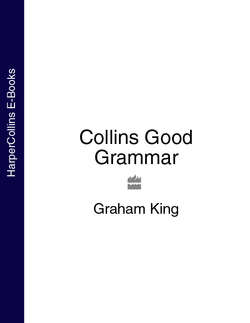Читать книгу Collins Good Grammar - Graham King - Страница 32
Phrases and Clauses
ОглавлениеWe’ve now surveyed the different classes of words we use to construct sentences. However we should, at this point, also familiarise ourselves with two units or groups of words that are usually found in sentences: phrases and clauses.
A phrase is a group of words working as a unit but unable to stand alone or to make sense, but the definition can also include single words. The logic of this is demonstrated when we shrink a conventional phrase:
I love that dry white wine from Australia.
I love that dry white wine.
I love that white wine.
I love that wine.
I love wine.
The sets of words in bold are all phrases. The key word wine is called the headword, and because it is a noun, all five phrases are called noun phrases.
There are five kinds of phrases, each named after the class of the headword:
| NOUN PHRASE | They loved their first home. (home is a noun) |
| VERB PHRASE | We have been burgled. (burgled is a verb) |
| ADVERB PHRASE | Come through the doorway. (through is an adverb) |
| ADJECTIVE PHRASE | It’s too difficult to do. (difficult is an adjective) |
| PREPOSITIONAL PHRASE | They walked along the path. (along is the introducing preposition; the path is a noun phrase) |
In the previous chapter we described three kinds of sentence: the simple sentence, consisting of a single main clause; the compound sentence, consisting of two or more main clauses, and the complex sentence, consisting of a main clause and one or more subordinate clauses. Fine – but what, exactly, are clauses?
A clause, quite simply, is a unit of related words which contains a subject and other words, always including a verb, which give us information about the subject:
The patient stopped breathing, so I shouted for the nurse.
In this example, The patient stopped breathing is a main clause of the sentence, because it can stand alone. In fact, if you put a full stop after breathing it becomes a legitimate sentence. But I shouted for the nurse is also a main clause because it can stand alone, too. What we have is a compound sentence consisting of two main clauses coordinated by the adverb so – here used as a conjunction:
| main clause | coordinator | main clause |
| The patient stopped breathing | so | I shouted for the nurse. |
Now let’s construct a sentence in a different way – this time with a main clause and a subordinate clause:
This is the patient who stopped breathing.
You can pick the main clause because it can stand on its own: This is the patient. The rest of the sentence consists of who stopped breathing, which is the subordinate clause because it can’t stand on its own:
| main clause | subordinate clause |
| This is the patient | who stopped breathing. |
You can add more information to a subordinate clause, but regardless of how much extra information you pile on it remains a subordinate clause because it is always subordinate to the main clause, serving only to influence the word patient:
| main clause | subordinate clause |
| This is the patient | who, when I visited the hospital yesterday, stopped breathing for several minutes. |
It’s worth spending a little more time with subordinate clauses because no matter how long they are they have the ability to function as nouns, adjectives and adverbs. Understanding this should help you construct more precise and efficient sentences.
We recognise three kinds of subordinate clauses:
| NOUN CLAUSE – where the clause acts as a noun. | She told him what she thought.What’s right and what’s wrong are the questions at the heart of true civilisation.I told him that Judy was coming. |
| ADJECTIVAL CLAUSE – where the clause acts as an adjective. | This is the door that won’t close properly.The parcel that’s just arrived is for you.London is the place which offers the greatest opportunities. |
| ADVERBIAL CLAUSE – where the clause acts as an adverb. | You should go there before the shops open.Because it began to rain I had to buy an umbrella.We were quite upset when John came in. |
Look at the noun clauses closely and you will see that they really do function as nouns. Try mentally rewriting the sentence She told him what she thought as She told him [thoughts] and – Presto! –the clause becomes a noun.
Do the same for the adjectival clauses. What the sentence This is the door that won’t close properly is saying is, This is the [jammed] door. The adjectival clause that won’t close properly is merely substituting for the adjective jammed. Incidentally, you may have noticed that the adjectival clauses are introduced by the relative pronouns that and which. These and who, where, whose, what and as are typically used for this purpose, which is why you may sometimes see adjectival clauses referred to as relative clauses.
